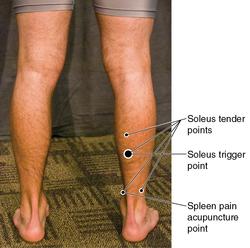Positional release therapy, also known by its parent term strain counterstrain, is a therapeutic technique that uses a position of comfort of the body, its appendages, and its tissues to resolve somatic dysfunction. Somatic dysfunction is defined as a disturbance in the sensory or proprioceptive system that results in spinal segmental tissue facilitation and inhibition (Korr 1975). Jones (1973) proposed that as a result of somatic dysfunction, tissues often become kinked or knotted resulting in pain, spasm, and a loss of range of motion. Simply, PRT unkinks tissues much as one would a knotted necklace, by gently twisting and pushing the tissues together to take tension off the knot. When one link in the chain is unkinked, others nearby untangle, producing profound pain relief (Speicher and Draper 2006a).
Essentially, PRT is the opposite of stretching. For example, if a patient has a tight, tender area on the calf, the clinician would traditionally dorsiflex the foot to stretch the calf to reduce the tightness and pain. Unfortunately, this might lead to muscle guarding and increased pain. Using the same example, a clinician who employs PRT would place the tender point in the position of greatest comfort (plantar flexion), shortening the muscle or tissue in order to relax them. A gentle and passive technique, PRT has been advocated for the treatment of acute, subacute, and chronic somatic dysfunction in people of all ages (Speicher and Draper 2006b). Dr. Lawrence Jones, an osteopathic physician, is credited with the discovery of the therapy in the early 1950s; he initially called it positional release technique and later coined the term strain counterstrain (Jones 1964).
Jones described his clinical discovery as "a lucky accident and nothing more" (Jones, Kusunose, and Goering 1995, 2). After Jones failed to help a patient with severe back pain, the patient said that his greatest challenge was sleeping at night and that if he could find a comfortable position, he might get relief. Jones assisted the patient into various positions and discovered that a fetal position provided the greatest pain reduction. He left him in this position while he examined another patient. Upon his return, the patient arose without pain for the first time in four months. Jones didn’t understand how placing a patient in a position of comfort for a short period of time could provide complete cessation of unrelenting pain after so many traditional therapies had failed. He then experimented with patient positioning with moderate success. Three years later he accidentally discovered that treatment of anterior pelvic tender points often relieved posterior pelvic pain. Based on this observation, Jones believed that tender points (TPs) were the result of a counterstrain mechanism: If a tissue is abruptly strained, the opposing tissue (antagonist) is counterstrained in its attempt to stabilize against the straining force, resulting in the production of antagonist TPs that prevent the agonist strained tissue from fully healing (Jones 1995).
Tender points, in contrast to myofascial trigger points (MTrPs), are not associated with hyperirritable bands of tissue, but are discrete areas of tissue tenderness that can occur anywhere in the body (Speicher and Draper 2006a). Myofascial trigger points are hyperirritable nodules of knotted muscular tissue that often entrap nerves and local vessels and cause pain, inflammation, and loss of function (Simons and Travell 1981). Myofascial trigger points, whether active or latent, are found in taut bands of muscular tissue. An active MTrP produces either local or referred pain or other sensory perception alterations with or without manual stimulation, whereas a latent trigger point requires manual stimulation to activate a potential pain or sensory response (Dommerholt, Bron, and Franssen 2006). Tender points can also be active or latent, but they are not commonly found within knotted muscle. Jones mapped TP locations based on segmental spinal levels, but TP locations have also been closely associated with the myofascial trigger point locations first described by Travell in 1949. Myofascial trigger points and possibly TPs may also be associated with ahi shi acupuncture points used for the treatment of pain (Hong 2000) as well as lymphatic reflex points (D’Ambrogio and Roth 1997). Melzack, Stillwell, and Fox (1977) asserted that not much difference existed between the locations of MTrPs and acupuncture points based on their finding of a 71% correlation. However, an investigation by Birch in 2003 of the correlation between trigger and acupuncture points reported in Melzack and colleagues’ study found a correlation of only 18 to 19%. Birch (2003) and Hong (2000) contended that not all acupuncture points correlate with MTrPs, but they believe that ahi shi acupuncture points used for pain control do. Jones (1964) was the first to correlate the use of specific body positioning to reduce tender and trigger point associated tenderness and spasm (see figure 1.1). In the calf area alone there are different trigger, tender, acupuncture and reflex points related to pain in the soleus muscle, many of which overlap one another. Melzack et al. (1977) outlines these in greater detail.

Figure 1.1 A comparison of trigger, tender, and acupuncture points.
This text not only presents and honors the foundational work of Jones, but also provides a user-friendly guide for the clinical application of PRT. Since Jones’ seminal work, research and clinical case reports have continued to emerge to support its use and efficacy for the treatment of a variety of painful ailments linked to somatic dysfunction (Wong 2012), including restless leg syndrome (Peters, MacDonald, and Leach 2012). Positional release practitioners have also advocated for its use as a comprehensive therapy.